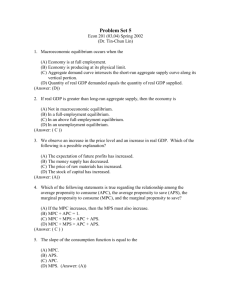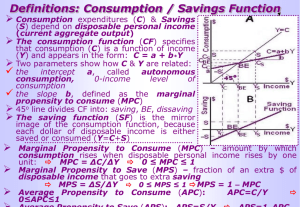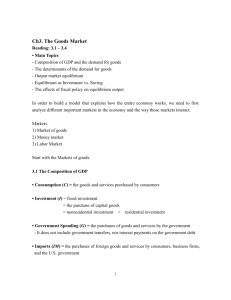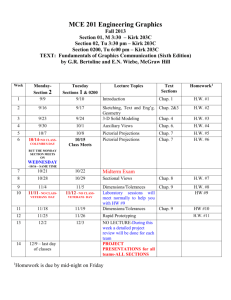Pre-Test Chapter 8 ed17
advertisement
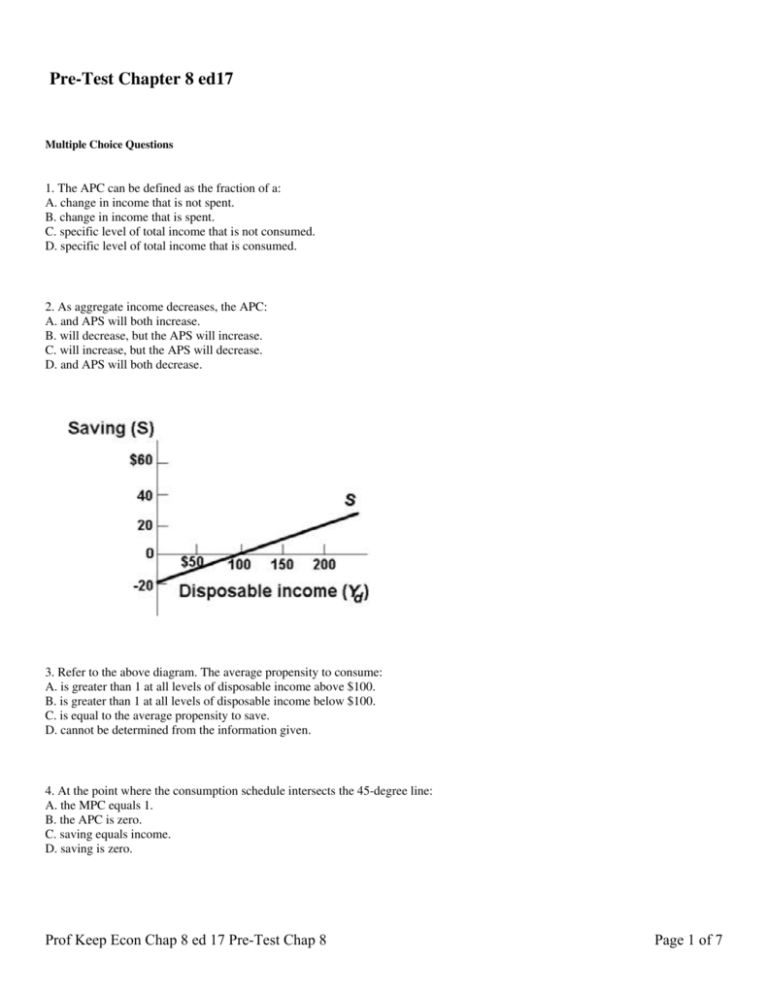
Pre-Test Chapter 8 ed17 Multiple Choice Questions 1. The APC can be defined as the fraction of a: A. change in income that is not spent. B. change in income that is spent. C. specific level of total income that is not consumed. D. specific level of total income that is consumed. 2. As aggregate income decreases, the APC: A. and APS will both increase. B. will decrease, but the APS will increase. C. will increase, but the APS will decrease. D. and APS will both decrease. 3. Refer to the above diagram. The average propensity to consume: A. is greater than 1 at all levels of disposable income above $100. B. is greater than 1 at all levels of disposable income below $100. C. is equal to the average propensity to save. D. cannot be determined from the information given. 4. At the point where the consumption schedule intersects the 45-degree line: A. the MPC equals 1. B. the APC is zero. C. saving equals income. D. saving is zero. Prof Keep Econ Chap 8 ed 17 Pre-Test Chap 8 Page 1 of 7 5. Assume there are no prospective investment projects (I) that will yield an expected rate of return (r) of 25 percent or more, but that there are $5 billion of investment opportunities with an expected rate of return between 20 and 25 percent, an additional $5 billion between 15 and 20 percent, and so on. If the real interest rate is 15 percent in this economy, the aggregate amount of investment will be: A. $25. B. $20. C. $15. D. $10. 6. Refer to the above figure. If the relevant saving schedule were constructed: A. saving would be minus $20 billion at the zero level of income. B. aggregate saving would be $60 at the $60 billion level of income. C. its slope would be 1/2. D. it would slope downward and to the right 7. If a $500 billion increase in investment spending increases income by $500 billion in the first round of the multiplier process and by $450 in the second round, income will eventually increase by: A. $2500 billion. B. $3000 billion. C. $4000 billion. D. $5000 billion. 8. Which of the following will not cause the consumption schedule to shift? A. a sharp increase in the amount of wealth held by households B. a change in consumer incomes C. the expectation of a recession D. a growing expectation that consumer durables will be in short supply 9. Other things equal, a 10 percent decrease in corporate income taxes will: A. decrease the market price of real capital goods. B. have no effect on the location of the investment-demand curve. C. shift the investment-demand curve to the right. D. shift the investment-demand curve to the left. Prof Keep Econ Chap 8 ed 17 Pre-Test Chap 8 Page 2 of 7 10. Given the consumption schedule, it is possible to graph the relevant saving schedule by: A. subtracting the MPC from 1 at each level of income. B. subtracting investment from consumption at each level of GDP. C. plotting the horizontal differences between the consumption schedule and the 45-degree line. D. plotting the vertical differences between the consumption schedule and the 45-degree line. 11. The multiplier is: A. 1/APS. B. 1/APC. C. 1/MPC. D. 1/MPS. 12. The consumption and saving schedules reveal that: A. consumption rises, but saving declines, as disposable income rises. B. saving varies inversely with the profitability of investment. C. saving varies directly with the level of disposable income. D. saving is inversely related to the rate of interest. 13. The saving schedule shown in the above diagram would shift downward if, all else equal: A. the average propensity to save increased at each income level. B. the marginal propensity to save rose at each income level. C. consumer wealth rose rapidly because of a significant increase in stock market prices. D. the real interest rate rose. 14. The size of the multiplier is equal to the: A. slope of the consumption schedule. B. reciprocal of the slope of the consumption schedule. C. slope of the saving schedule. D. reciprocal of the slope of the saving schedule. Prof Keep Econ Chap 8 ed 17 Pre-Test Chap 8 Page 3 of 7 15. Other things equal, a decrease in the real interest rate will: A. shift the investment demand curve to the right. B. shift the investment demand curve to the left. C. move the economy upward along its existing investment demand curve. D. move the economy downward along its existing investment demand curve. 16. Which one of the following will cause a movement down along an economy's consumption schedule? A. an increase in stock prices B. a decrease in stock prices C. an increase in consumer indebtedness D. a decrease in disposable income 17. The most important determinant of consumption and saving is the: A. level of bank credit. B. level of income. C. interest rate. D. price level. 18. Which of the following relations is not correct? A. 1 - MPC = MPS B. APS + APC = 1 C. MPS = MPC + 1 D. MPC + MPS = 1 Answer the next question(s) on the basis of the following table that illustrates the multiplier process. 19. Refer to the above table. The total change in income resulting from the initial change in investment will be: A. $100. B. $20. C. $80. D. $200. Prof Keep Econ Chap 8 ed 17 Pre-Test Chap 8 Page 4 of 7 Answer the next question(s) on the basis of the following consumption schedules. DI signifies disposable income and C represents consumption expenditures. All figures are in billions of dollars. 20. Refer to the above data. At an income level of $40 billion, the average propensity to consume: A. is highest in economy (1). B. is highest in economy (2). C. is highest in economy (3). D. cannot be determined from the data given. 21. The investment demand curve suggests: A. that changes in the real interest rate will not affect the amount invested. B. there is an inverse relationship between the real rate of interest and the level of investment spending. C. that an increase in business taxes will tend to stimulate investment spending. D. there is a direct relationship between the real rate of interest and the level of investment spending. 22. The greater is the marginal propensity to consume, the: A. smaller is the marginal propensity to save. B. higher is the interest rate. C. lower is the average propensity to consume. D. lower is the price level. 23. If for some reason households become increasingly thrifty, we could show this by: A. a downshift of the saving schedule. B. an upward shift of the consumption schedule. C. an upward shift of the saving schedule. D. an increase in the equilibrium GDP. 24. The investment demand curve will shift to the right as a result of: A. an increase in the excess production capacity available in industry. B. an increase in business taxes. C. technological progress. D. an increase in the acquisition and maintenance cost of capital goods. Prof Keep Econ Chap 8 ed 17 Pre-Test Chap 8 Page 5 of 7 25. (Advanced analysis) If the equation for the consumption schedule is C = 20 + 0.8Y , where C is consumption and Y is disposable income, then the average propensity to consume is 1 when disposable income is: A. $80. B. $100. C. $120. D. $160. 26. Which of the following would shift the investment demand curve from ID1 to ID2? A. a lower interest rate B. lower expected rates of return on investment C. a higher interest rate D. higher expected rates of return on investment 27. The APC is calculated as: A. change in consumption / change in income B. consumption / income C. change in income / change in consumption D. income / consumption Prof Keep Econ Chap 8 ed 17 Pre-Test Chap 8 Page 6 of 7 28. Refer to the above diagram. The break-even level of income is: A. zero. B. $150. C. $60. D. $120. 29. Refer to the above data. The marginal propensity to save: A. is highest in economy (1). B. is highest in economy (2). C. is highest in economy (3). D. cannot be determined from the data given. 30. Refer to the above table. The marginal propensity to consume is: A. .5. B. .75. C. .8. D. .9. Pre-Test Chapter 8 ed17 Key 1. D 2. C 3. B 4. D 5. D 6. A 7. D 8. B 9. C 10. D 11. D 12. C 13. C 14. D 15. D 16. D 17. B 18. C 19. A 20. B Prof Keep Econ Chap 8 ed 17 Pre-Test Chap 8 21. B 22. A 23. C 24. C 25. B 26. D 27. B 28. B 29. A 30. C Page 7 of 7
